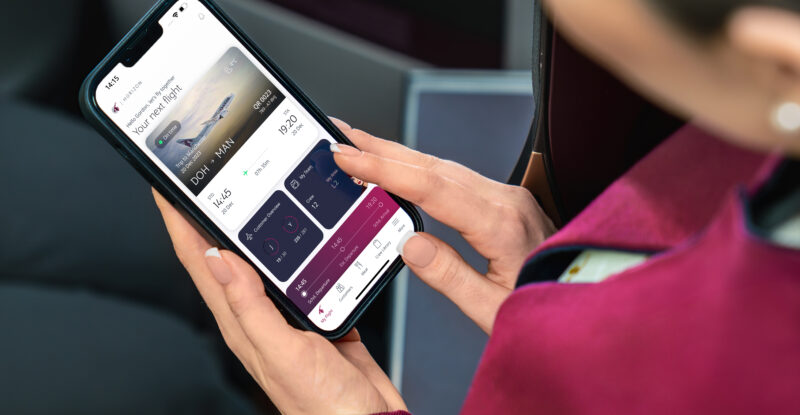 Operating a fleet of 250 aircraft to 170-plus destinations via its Doha hub, Qatar Airways has a track record for innovating in the passenger experience (PaxEx) space. Its QSuite business class product is regularly celebrated as among the best in the world. Its Oryx One app allows passengers to explore in advance the vast entertainment options available in-flight and to download digital newspapers and magazines for free. And the carrier is renowned for its hospitality.
Operating a fleet of 250 aircraft to 170-plus destinations via its Doha hub, Qatar Airways has a track record for innovating in the passenger experience (PaxEx) space. Its QSuite business class product is regularly celebrated as among the best in the world. Its Oryx One app allows passengers to explore in advance the vast entertainment options available in-flight and to download digital newspapers and magazines for free. And the carrier is renowned for its hospitality.
But late last year, Qatar Airways started introducing the next phase of its digital transformation by progressively arming 15,000 cabin crew members with iPhones to deliver a more personalized experience on board. An in-house application on the devices offers real-time insights about flight information, as well as guest and service information, enabling crew members to view passengers’ profiles — including Privilege Club loyalty members and Oneworld members — as well as all special service requests and preferences.
Attempting to revolutionize PaxEx through personalization and improve operational services in this fashion is no small task. Indeed, it has been “a long journey”, Qatar Airways senior vice president of product development and design Xia Cai confided to Airline Passenger Experience Association CEO Joe Leader at the APEX TECH conference in Los Angeles.
That journey required a “holistic approach to the vision of the project” and saw cabin crew members, including 100 testers, work with the carrier’s IT and digital teams to ensure a seamless rollout both in terms of the frontend experience for customers, and backend processes.
Though there will be many iterative software updates, said Cai, an important upgrade was launched on 20 February — a dining module that enables crew to facilitate onboard ordering with guests. The software is fully integrated with the carrier’s backend systems to help manage catering inventory which in turn assists with Qatar Airways’ sustainability initiatives and efforts to reduce wastage.
The app also helps Qatar Airways to streamline service recovery. “You know, if there’s an issue with an IFE [system], if there’s an issue with the meals, the crew are able to react immediately, and that data also going back to the operational teams really helps to make sure that we continuously improve,” said Cai.
Qatar Airways is innovating in other ways. In 2022, it inked an agreement to be a launch customer for Panasonic Avionics’ new Astrova embedded IFE system, which addresses many IFE pain points, including with software designed to enhance passenger engagement and support personalization. The system is destined for the carrier’s forthcoming fleet of 40 Boeing 777X twinjets.
“The design itself is beautiful; mood lighting is integrated within our interior,” noted Cai, whilst showing a photo of a large “industry-setting” Astrova OLED monitor and swappable illuminated peripheral bar, which will be installed in business class on the 777X.
Qatar Airways is, she said, “so obsessed about detail” and “the whole ambiance has to come together”. So, Astrova “works very well with our industrial design DNA”.
 Behind the scenes, a separate Panasonic solution, called Modular Interactive (MI), will be in play at Qatar Airways. An interactive design and publishing tool, MI enables the airline to quickly create unique, easy-to-implement seatback interactives.
Behind the scenes, a separate Panasonic solution, called Modular Interactive (MI), will be in play at Qatar Airways. An interactive design and publishing tool, MI enables the airline to quickly create unique, easy-to-implement seatback interactives.
Because MI is pre-tested and pre-integrated, it allows airlines to onboard apps faster. “We all get stuck with designing the GUI; we live with it for five or six years, seven years, and we have to run an ATP … So that whole process is gone,” explained the Qatar Airways executive of MI.
She said MI also means that the carrier “can be really dynamic” and tie in all of its sponsorships, including with Doha’s Hamad International Airport and duty free program. This then feeds into the carrier’s passenger personalization work.
As new digital features roll out at Qatar Airways, the carrier will remain mindful of customers’ privacy and focused on hospitality, assured the Qatar Airways executive at APEX TECH.
“We always remind ourselves don’t over-engineer,” she said noting for instance that the carrier will not remove menu cards from the aircraft even though crew can avail of the digital version on their devices. “We can keep it on the IFE, but we don’t want to lose … the human touch.”
Indeed, providing that human touch is the very reason why Qatar Airways has opted to arm its crew with iPhones in the first place.
The carrier also plans to expand the scope of its digital work to Hamad International and overseas airports and lounges, integrating passengers’ unique itinerary and requirements across all touch-points.

Qatar Airways SVP of product development and design Xia Cai was interviewed by APEX CEO Joe Leader at APEX TECH
Related Articles:
- Anuvu SVP Estibaliz Asiain on content trends driving IFE
- Qatar Airways mum on install details as it vows complimentary Starlink
- How Panasonic Avionics designed its Astrova IFE to be future-proof
- Inside Panasonic’s 30% lighter, 4K OLED HDR IFE system, Astrova
- Delta’s CSP, Touch, on how Delta Sync fosters collaboration
Featured image credited to Qatar












